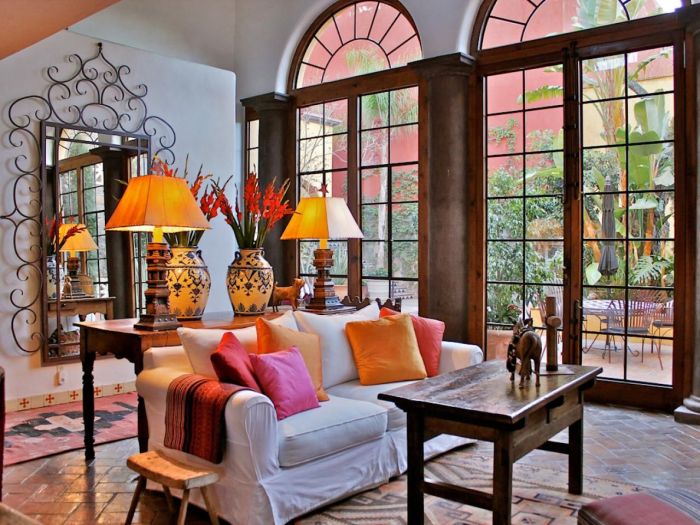Color schemes for home decor takes center stage, beckoning readers into a world of vibrant hues and harmonious combinations, ensuring an engaging and informative journey ahead.
Exploring the impact of colors on mood and atmosphere, the art of blending different schemes, and the importance of balance in creating a visually appealing space awaits you in the following sections.
Color Psychology

Color psychology plays a crucial role in determining the mood and atmosphere of a room. Different colors can evoke various emotions and feelings, ultimately impacting how we perceive a space.
Learn about more about the process of Home decor for kitchen in the field.
Warm vs. Cool Color Schemes
Warm colors such as red, orange, and yellow are known to create a cozy and inviting atmosphere. They can make a room feel more intimate and energetic. In contrast, cool colors like blue, green, and purple tend to have a calming effect and can make a space feel more spacious and serene.
Choosing Colors Based on Function
When selecting colors for a room, it’s essential to consider the function of the space. For example, a relaxing bedroom may benefit from soft and soothing colors like pastels or neutrals, while an energizing office could benefit from vibrant and stimulating hues like red or orange.
Popular Color Schemes
When it comes to choosing color schemes for home decor, it’s essential to consider the style of your interior design. Different styles, such as modern, farmhouse, and minimalist, each have their own popular color schemes that can help create a cohesive and harmonious look in your space.
Modern Style
In modern interior design, popular color schemes often include a combination of neutral colors like white, gray, and beige, along with bold accent colors such as navy blue, emerald green, or mustard yellow. These colors create a sleek and sophisticated look that is both timeless and trendy.
Farmhouse Style, Color schemes for home decor
For a farmhouse-inspired home decor, popular color schemes typically feature warm and inviting tones like creamy whites, soft blues, and earthy greens. Mixing in natural wood accents and rustic textures can enhance the cozy and welcoming feel of a farmhouse-style space.
Minimalist Style
In minimalist interior design, less is more when it comes to color schemes. Neutral colors like white, black, and shades of gray are commonly used to create a clean and uncluttered look. Adding a pop of color through a single vibrant accent can add interest and personality to a minimalist space.
Creating Balance
:max_bytes(150000):strip_icc()/0kmO3S-5abd026bc064710036d572cc.jpg?w=700)
When it comes to home decor, achieving balance with color is essential for creating a harmonious and visually appealing space. Color balance involves the strategic use of different hues to ensure that no single color overwhelms the room, but rather all colors work together cohesively.
Using Neutral Colors to Balance Bold Hues
One effective way to create balance in home decor is by incorporating neutral colors to offset bold or vibrant hues. For example, pairing a bold red accent wall with neutral beige or gray furniture can help tone down the intensity of the red while still allowing it to make a statement.
The 60-30-10 Rule
The 60-30-10 rule is a popular guideline used by interior designers to create a well-balanced color palette in a room. According to this rule, 60% of the room should be a dominant color (usually a neutral or light shade), 30% should be a secondary color (a bit bolder than the dominant color), and 10% should be an accent color (the boldest hue that adds pops of color throughout the space).
Color Trends and Seasons: Color Schemes For Home Decor

Color trends in home decor are often influenced by the changing seasons. As the seasons shift throughout the year, different color palettes become more popular in interior design. Color forecasting plays a significant role in determining which colors will be trending during each season, helping homeowners and designers stay ahead of the curve.
Incorporating Seasonal Colors
When it comes to incorporating seasonal colors into your home decor, you don’t necessarily need to completely overhaul your space. Simple updates such as swapping out throw pillows, curtains, or small decor items can instantly bring a touch of the season into your home. For example, in the spring and summer, you might opt for bright and vibrant hues like pastel pinks, blues, and yellows to create a light and airy feel. In the fall and winter, warmer tones like deep reds, oranges, and browns can add a cozy and inviting atmosphere to your space.
In conclusion, mastering the art of color schemes for home decor is key to transforming any space into a personalized sanctuary. From understanding color psychology to staying updated on seasonal trends, let your creativity flourish and your home shine with the perfect palette.

